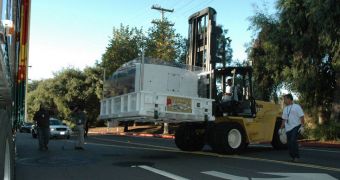According to officials at the JPL, one of the cameras that was on the Hubble Space Telescope has just been shipped away from the facility, and will now head for display elsewhere.
This instrument is known informally among space enthusiasts as “The Camera That Saved Hubble,” and it played a hugely important role in making the masses feel attracted to space and the Universe.
Some of the most iconic images that Hubble made over the years were taken with the Wide Field and Planetary Camera 2 (WFPC 2), an instrument that was built in Pasadena, California.
The tool is about the size of a baby grand piano, and it remained on the venerable telescope until it was removed by astronauts last May.
Space shuttle Atlantis flew an 11-day mission to the Hubble, during which five astronauts changed just about everything they could on the observatory, except for the chassis.
The $1.2 billion mission replaced the WFPC 2 with the Wide Field Camera 3 (WFC3), which is a lot more advanced since it was developed using new technologies.
The Advanced Camera for Surveys (ACS) instrument was also fixed, and Atlantis astronauts even installed new gyroscopes and thermal coatings. When they left, the telescope was in better condition than ever before.
The WFPC 2 was brought back to Earth, and then sent to the Smithsonian Air and Space Museum, in Washington DC. It was loaned by the JPL from there, and kept on display at the facility until October 13.
During this time, visitors, media representatives and school children had a chance to see the instrument first hand, and to hear explanations about how it works from the very people who built it.
The Wide Field Camera 2 was developed and built by the NASA Jet Propulsion Laboratory (JPL), which is a division of the California Institute of Technology, in Pasadena.
At this point, the camera is heading for the Denver Museum of Nature and Science, in Colorado, where it will remain for only a short period of time, before returning to the Smithsonian.
The WFC 2 itself was an emergency solution for Hubble, given that the telescope launched with a faulty mirror from the get-go. The camera was installed during a 1993 repair mission to eliminate the effects of the flaw.
In total, the instrument spent 15 years in space, during which time it snapped most of the iconic Hubble images, in great resolution and detail.
Once it returns to Washington DC, it will go on permanent display at the Smithsonian.

 14 DAY TRIAL //
14 DAY TRIAL //